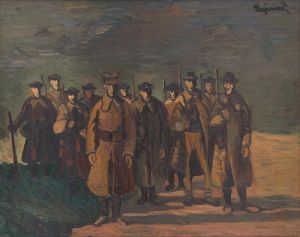
Stoomketel
A hand-painted replica of Richard Nicolaüs Roland Holst’s masterpiece Stoomketel, meticulously crafted by professional artists to capture the true essence of the original. Each piece is created with museum-quality canvas and rare mineral pigments, carefully painted by experienced artists with delicate brushstrokes and rich, layered colors to perfectly recreate the texture of the original artwork. Unlike machine-printed reproductions, this hand-painted version brings the painting to life, infused with the artist’s emotions and skill in every stroke. Whether for personal collection or home decoration, it instantly elevates the artistic atmosphere of any space.
Richard Nicolaüs Roland Holst was a Dutch artist known for his contributions to the arts during the late 19th and early 20th centuries. He was a prominent figure in the Dutch art scene and was associated with various artistic movements of his time. However, specific information about a painting titled "Stoomketel" by Richard Nicolaüs Roland Holst is not readily available in historical records or major art references. It is possible that this work is lesser-known or not widely documented in public art collections or literature.
Richard Roland Holst was born on December 4, 1868, in Amsterdam, Netherlands. He was part of a family with strong artistic and intellectual ties. His wife, Henriette Roland Holst, was a well-known poet and socialist. Richard studied at the Rijksakademie van Beeldende Kunsten (State Academy of Fine Arts) in Amsterdam, where he honed his skills in painting and drawing. He became a versatile artist, engaging in various forms of art, including painting, illustration, and design.
Throughout his career, Roland Holst was influenced by the Arts and Crafts Movement, which emphasized traditional craftsmanship and the decorative arts. He was also associated with the Amsterdamse Joffers, a group of female artists in Amsterdam, and was involved in the socialist movement, which often informed the themes and subjects of his work. His art is characterized by a strong sense of design and often features allegorical and symbolic elements.
In addition to his work as a painter, Roland Holst was a prolific designer of book covers, posters, and stained glass. He was a professor at the Rijksakademie and played a significant role in the education of future generations of artists. His influence extended beyond his own work, as he was deeply involved in the cultural and political discussions of his time.
While specific details about "Stoomketel" are not available, Roland Holst's body of work often reflects his interest in social themes and his commitment to integrating art into everyday life. His contributions to Dutch art are recognized for their artistic quality and their engagement with the social issues of his era.
For those interested in exploring Roland Holst's work, it may be beneficial to visit Dutch museums or archives that house collections of his art, as well as publications that discuss his contributions to the arts and his role in the cultural movements of his time.


















